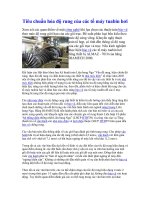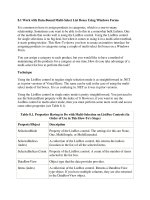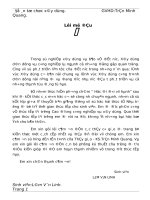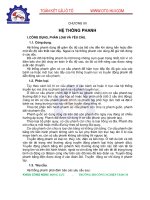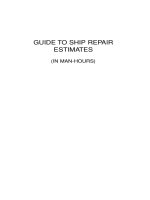"It is impossible to avoid all faults" doc
Bạn đang xem bản rút gọn của tài liệu. Xem và tải ngay bản đầy đủ của tài liệu tại đây (16.04 MB, 488 trang )
1 Introduction
Today, the term reliability is part of our everyday language, especially
when speaking about the functionality of a product. A very reliable prod-
uct is a product that fulfils its function at all times and under all operating
conditions. The technical definition for reliability differs only slightly by
expanding this common definition by probability: reliability is the prob-
ability that a product does not fail under given functional und environ-
mental conditions during a defined period of time (VDI guidelines 4001).
The term probability takes into consideration, that various failure events
can be caused by coincidental, stochastic distributed causes and that the
probability can only be described quantitatively. Thus, reliability includes
the failure behaviour of a product and is therefore an important criterion
for product evaluation. Due to this, evaluating the reliability of a product
goes beyond the pure evaluation of a product’s functional attributes.
According to customers interviewed on the significance of product at-
tributes, reliability ranks in first place as the most significant attribute, see
Figure 1.1. Only costs are sometimes considered to play a more important
role. Reliability, however, remains in first or second place. Because reli-
ability is such an important topic for new products, however it does not
maintain the highest priority in current development.
Assessment Scale
from 1 (very important)
to 4 (unimportant)
1.6
1.6
1.6
1.7
1.9
2.1
2.1
2.1
2.6
0 0.5 1 1.5 2 2.5 3 3.5 4
Reliability
Fuel Consumption
Price
Design
Standart Equipment
Repair-/Maintanence Costs
Resale Value
Service Network
Delivery Time
Prestige
Good Price by Trade-in
1.3
2.5
Figure 1.1. Car purchase criteria (DAT-Report 2007)
„It is impossible to avoid all faults“
„Of cause it remains our task to avoid
faults if possible“
Sir Karl R. Popper
B. Bertsche, Reliability in Automotive and Mechanical Engineering. VDI-Buch,
doi: 10.1007/978-3-540-34282-3_1, © Springer-Verlag Berlin Heidelberg 2008
2 1 Introduction
Surveys show that customers desire reliable products. How does prod-
uct development reflect this desire in reality? Understandably, companies
protect themselves with statements concerning their product reliability. No
one wants to be confronted with a lack of reliability in their product. Often,
these kinds of statements are kept under strict secrecy. An interesting sta-
tistic can be found at the German Federal Bureau of Motor Vehicles and
Drivers (Kraftfahrt-Bundesamt) in regards to the number of callbacks due
to critical safety defects in the automotive industry: in the last ten years the
amount of callbacks has tripled (55 in 1998 to 167 in 2006), see Figure 1.2.
The related costs have risen by the factor of eight! It is also well known,
that guarantee and warranty costs can be in the range of a company’s profit
(in some cases even higher) and thus make up 8 to 12 percent of their turn-
over. The important triangle in product development of cost, time and
quality is thus no longer in equilibrium. Cost reductions on a product, the
development process and the shortened development time go hand in hand
with reduced reliability.
Amount of callbacks
0
10
20
30
40
50
60
70
80
90
100
110
120
130
1998 1999 2000 2001 2002 2003 2004 2005 2006
140
55
64
72
86
105
116
137
123
167
150
160
170
Figure 1.2. Development of callbacks in automotive industry
Today’s development of modern products is confronted with rising
functional requirements, higher complexity, integration of hardware, soft-
ware and sensor technology and with reduced product and development
costs. These, along with other influential factors on the reliability, are
shown in Figure 1.3.
1 Introduction 3
System / Product
with mechanics / materials,
elektronics, sensors und software
in macro or microtechnology
Higher
Functionality
Increased
Product Liability
Increased
Costomer Requirements
Reduced
Development Costs
Minimization of
Failure costs
Complexity
Higher
Shorter
Development Times
Figure 1.3. Factors which influence reliability
To achieve a high customer’s satisfaction, system reliability must be ex-
amined during the complete product development cycle from the view-
point of the customer, who treats reliability as a major topic. In order to
achieve this, adequate organizational and subject related measures must be
taken. It is advantageous that all departments along the development chain
are integrated, since failures can occur in each development stage. Meth-
odological reliability tools, both quantitative and qualitative, already exist
in abundance and when necessary, can be corrected for a specific situation.
A choice in the methods suitable to the situation along the product life
cycle, to adjust them respectively to one another and to implement them
consequently, see Figure 1.4, is efficacious.
Planing
Design
Production
Field
usage
Conception
Recycling
Reliability
Target
Lasten -
heft
- Fuzzy Data
- Know-How
-
time
- ABC- Analysis
- Design Review
- FMEA
-FTA
-
- Weibull, Exponential
- Testplaning
- Boolean Theory
- Markov Model
-
-Qualitiy
Management
- Audit
- Statistical
Process
Planing
-
- Field Data
Collection
- Early
Warning
-
- Field Data
Analysis
-
- Recycling
Potential
-
- Remaining
Lifetime
-
Qualitative
Quantitative
Specifi-
cations
Calculation
-
FTA
-
Q
Layout
Figure 1.4. Reliability methods in the product life cycle
4 1 Introduction
A number of companies have proven, even nowadays, that it is possible
to achieve very high system reliability by utilizing such methods.
The earlier reliability analyses are applied, the greater the profit. The
well-known “Rule of Ten” shows this quite distinctly, see Figure 1.5. In
looking at the relation between failure costs and product life phase, one
concludes that it is necessary to move away from reaction constraint in
later phases (e.g. callbacks) and to move towards preventive measures
taken in earlier stages.
Costs per Failure
1.00
10.00
100.00
0.10
Failure Prevention Failure Detection
Chance to Act Need to React
Design FieldProduction
Figure 1.5. Relation between failure costs and product life phase
The easiest way to determine the reliability of a product is in hindsight,
when failures have already been detected. However, this information is
used for future reliability design planning. As mentioned earlier, however,
the most sufficient and ever more required solution is to determine the
expected reliability in the development phase. With the help of an appro-
priate reliability analysis, it is possible to forecast the product reliability, to
identify weak spots and, if needed, comparative tests can be carried out,
see Figure 1.6.
For the reliability analysis quantitative or qualitative methods can be
used. The quantitative methods use terms and procedures from statistics
and probability theory. In Chapter 2 the most important fundamental terms
of statistics and probability theory are discussed. Furthermore, the most
common lifetime distributions will be presented and explained. The
Weibull distribution, which is mainly and commonly used in mechanical
engineering, will be explained in detail.
1 Introduction 5
System Reliability Assurance
Constructive:
Optimal construction prozess
with sophisticated construction
techniques and -methods
• genaues und voll-
ständiges Lasten-
heft
• gesicherte
Berechnung mit
genau erfaßten Last-
kollektiven
• bewährte
Konstruktions-
richtlinien
• frühzeitige und um-
fassende Erprobung
•
• exact and complete
specifications
•
•
•
•
Analytical:
Determination and/or reliability prediction
by reliability techniques and afterwards
optimization
Target:
• calculation of the
predictable reliability
•
•
•
methods:
- Boole
-
Markoff
- FTA
-
quantitative
• Systematische
Untersuchung der
Auswirkungen von
• Ausfallartenanalyse
•
Methoden:
- FMEA/FMECA
- FTA
- Ereignisablauf-
analyse
- Checklisten
• systematical analysis
of effects of faults
and failures
•
•
methods:
- FMEA/FMECA
- FTA
- event sequence
analysis
- checklists
-
qualitative
- reliability prediction
- detection of weaknesses
- realization of comparative trial
assured calculation
with exact collected
load collectives
established
construction guidelines
early and broad
tesing
failure rate
probabalistic
reliability analysis
failure analysis
Figure 1.6. Securing of system reliability
Chapter 3 illustrates an example of a complete reliability analysis for a
simple gear transmission. The described procedure is based on the funda-
mentals and methods described in the previous chapter.
The most well-known qualitative reliability method is the FMEA (Fail-
ure Mode and Effects Analysis). The essential contents, according to the
current standard in the automotive industry (VDA 4.2), are shown in Chap-
ter 4.
The fault tree analysis, described in Chapter 5, can be used either as a
qualitative or as a quantitative reliability method.
One main focus of this book is the analysis of lifetime tests and damage
statistics, which will be dealt with in Chapter 6. With these analyses gen-
eral valid statements concerning failure behaviour can be made. In order to
describe the lifetime distribution the Weibull distribution is used, which is
the most common distribution in mechanical engineering. Next to the
graphical analyses of failure times, analytical analyses and their theoretical
basics will be discussed. The important terms "order statistic" and "confi-
dence range" will be explained in detail.
There is little collected and edited information pertaining the failure be-
haviour of mechanical components. However, the knowledge of the failure
6 1 Introduction
behaviour of a component is necessary, in order to be able to predict the
expected reliability under similar application conditions. With the help of
system theory it is also possible to calculate the expected failure behaviour
of a system. In Chapter 7 results from a reliability data base for the ma-
chine components gear wheels, axles and roller bearings will be presented.
In many cases the indicated Weibull parameters can prove to serve as a
first orientation.
To prove reliabilities before the start of production, it is obligatory to
carry out the appropriate tests. Here, the amount of test specimens, the
required test period length and the achievable confidence level may be of
interest. In Chapter 8 the planning of reliability tests will be described.
Each quantitative reliability method portrays a kind of enhanced fatigue
strength calculation. The basic principles of a lifetime calculation for ma-
chine components are summarized in Chapter 9.
The reliability and the availability of systems, which include repairable
elements, can be determined by various calculation models. Chapter 10
describes methods in their differing complexity and their assessment for
repairable elements.
In order to achieve high system reliability, an integrated process treat-
ment is compulsory. For this, a reliability safety program has been devel-
oped. This program will be described with its basic elements in Chapter
11. In conclusion, this chapter offers a complete overview on an optimal
reliability process.
For all the chapters there are problems at the end of each one and the so-
lutions can be found at the end of chapter 11.
2 Fundamentals of Statistics and Probability
Theory
A qualitative reliability analysis provides a conceptual basis for the de-
gree of confidence placed on a particular component or system and should
be capable in the incipient stages of design for alteration of these compo-
nents. A quantitative reliability prognosis gives a probability assessment of
the component based on well founded statistical techniques. This chapter
therefore, outlines the various methods of both qualitative and quantitative
methods shown in Figure 2.1.
Design Phase
Goals: - Prognosis of the expected reliability
- Recognition and elimination of weak points
- Execution of comparative studies
Reliability in the
-
-
-
systematical evaluation of the
effects of faults and failures
failure type analysis
Methoden:
• FMEA / FMECA
•FTA
• result action analysis
• check lists
•
qualitative
calculation of the expectied
reliability
failure rate analysis
probability based
reliability prognisis
Method:
• Boole
• Markoff
•FTA
•
quantitative
Figure 2.1. Options for reliability analysis
The results of the Wöhler tests in Figure 2.2 and Figure 2.3 show this.
Despite identical conditions and loads, strongly differing down times re-
sulted [2.15]. Out of these results it is not possible to assign a bearable
cycles-to-failure to a component. The cycles-to-failure n
LC
or the lifetime t
B. Bertsche, Reliability in Automotive and Mechanical Engineering. VDI-Buch,
doi: 10.1007/978-3-540-34282-3_2, © Springer-Verlag Berlin Heidelberg 2008
8 2 Fundamentals of Statistics and Probability Theory
can be seen as random variables, which are subject to a certain statistical
spread [2.1,
2.5, 2.23, 2.29, 2.33]. When looking at reliability, the desig-
nated range of dispersion between n
LC, min
and n
LC, max
as well as which
down times occur more often are of interest. For this it is necessary to
know how the lifetime values are distributed.
640
Load Cycles n
Root Bending Stress σ
5
10
100
·10
3
500
200
400
600
1000
Wöhler curve
N
mm
2
50
LC
Figure 2.2. Tooth failure – Wöhler test [2.15] with the statistical spread of down
times
200 250 300 350 400 450
Load Cycles n
·10
2
50
%
30
20
10
0
Failures
n
LC, min
n
LC, max
LC
Figure 2.3. Histogram for the frequency of the load σ = 640 N/mm
2
from Figure
2.2
2.1 Fundamentals in Statistics and Probability Theory 9
Terms and procedures from statistics and probability theory can be used
for down times observed as random events. Therefore, the most important
terms and fundamentals from statistics and probability theory will be dealt
with in Section 2.1.
An introduction and explanations of generally used lifetime distributions
is presented in Section 2.2. In this section the Weibull distribution, one of
the most adopted in mechanical engineering will be explained.
Section 2.3 combines component reliability with system reliability with
the help of Boolean theory. The Boolean theory can be understood as the
fundamental system theory. Other system theories can be found in Chapter
10.
2.1 Fundamentals in Statistics and Probability Theory
The failure behaviour of components and systems can be represented
graphically with various statistical procedures and functions. How this is
done will be described in this chapter. Furthermore, “values” will be dealt
with, with which the complete failure behaviour can be reduced to individ-
ual characteristic key figures. The result is a very compressed but also
simplified description of the failure behaviour.
2.1.1 Statistical Description and Representation of the Failure
Behaviour
In the following sections the four different functions for representing
failure behaviour will be introduced. The individual functions stem from
the observed failure times and can be carried over to one another. With
each function certain statements can be made concerning the failure behav-
iour. The use of a certain function therefore depends on a specific question
posed.
2.1.1.1 Histogram and Density Function
The simplest possibility to display failure behaviour graphically is with
the histogram of the failure frequency, see Figure 2.4.
The failure times in Figure 2.4a occur at random within a certain time
period. The representation in Figure 2.4b is the result after sorting the
strewed failure times.
10 2 Fundamentals of Statistics and Probability Theory
Trial
1
2
3
4
5
6
7
8
9
10
11
12
a)
Trial
1-12
b)
c)
Failure Time
200 250 300 350 400 450
Load Cycles n ·10
2
50
%
30
20
10
0
Failures
n
LC, min
n
LC, max
LC
Figure 2.4. Failure times and histogram of the failure frequencies for a stress of
σ = 640 N/mm
2
from Figure 2.2: a) collected failure times in trials; b) sorted fail-
ure times; c) histogram of the failure frequencies with empirical density func-
tion f
*
(t)
The denser the data lay together in Figure 2.4b, the more “frequently”
the failure times occur in that certain period. In order to show this graphi-
cally, a histogram of the failure frequencies is created, Figure 2.4c.
Therefore, the abscissa is divided into intervals of time which are de-
noted as classes. The quantity of failures is determined for each class. If a
failure falls directly between two classes, then it is counted to both classes
as half a failure. However, by assigning the intervals carefully, this can
normally be avoided. The quantity of failures in each class is represented
by beams with various respecting heights.
For the height or y-coordinate of each beam, the absolute frequency
2.1 Fundamentals in Statistics and Probability Theory 11
Aabs
nh
=
= class onein failures ofnumber
(2.1)
or the more common, relative frequency
n
n
h
A
rel ==
failures ofnumber total
class onein failures ofnumber
(2.2)
can be used. In Figure 2.4c the beam heights are determined using the rela-
tive frequency, as can be seen on the percent scale for the ordinate.
The division of the time axis into classes and the assignment of failure
times to the individual classes is called classification. In this process in-
formation is lost, since a certain amount of failures is assigned to one fre-
quency independent of the exact failure time in the interval. Through the
classification, each failure within a certain class is assigned the value of
that class’s mean. However, a loss of information is compensated by a win
in overview.
The amount of classes is not always simple to determine. If the classes
are chosen to be too large, then too much information is lost. In an extreme
case, there is only one beam, which of course offers little overview. If the
classes are chosen to be too small, small breaks can occur along the time
axis. Such breaks interrupt the continuity of the failure behaviour and are
thus unfit for a correct description.
The following Equation (
2.3) can be used for a rough approximation or
first estimate for the amount of classes [2.30]:
valuesalexperimentor failures ofnumber Total classes ofAmount ≈
nn
c
≈ .
(2.3)
Alternative approaches to calculate the amount of classes and the class
size are given in [2.30]:
nn
c
log32,31
⋅
+
≈ ,
(2.4)
3
2 nn
c
⋅≈ ,
(2.5)
nn
c
log5
⋅
≈
.
(2.6)
Up to a test specimen size of n = 50 the results are comparable, but the
results differ strongly for larger test specimen sizes. A rule of thumb for
estimating the class size b of a frequency distributions is based on the
range R and the test specimen size n:
12 2 Fundamentals of Statistics and Probability Theory
n
R
b
log32,31 ⋅+
≈ .
(2.7)
The range R is the difference between the largest and smallest value
within the test specimen.
minLC,maxLC,
nnR −=
.
(2.8)
Instead of in a histogram, the failure behaviour can also be described
with the often used “empirical density function f
*
(t), see Figure 2.5.
200 250 300 350 400 450
Load Cycles n ·10
2
50
%
30
20
10
0
Failures
n
LC, min
n
LC, max
Empirical Density Function f*(t)
LC
Figure 2.5. Histogram of failure frequencies and the empirical density func-
tion f
*
(t)
In the density function the midpoints of the beams in the histogram are
connected with straight lines. In this way a function between the failure
time and failure frequency is represented. The term “empirical” for the
density function implies, that the density function is determined based on a
test specimen or a limited number of failures.
The actual “ideal” density function is reached when the amount n of
tested components is increased. The amount of classes can then be raised
according to the simple Equation (2.3). This means that the class size be-
comes continually smaller while the y-coordinate of the resulting frequen-
cies remains relatively unchanged. For the limit n → ∞ the contour of the
histogram becomes an ever smoother and continuous curve, see Figure 2.6.
2.1 Fundamentals in Statistics and Probability Theory 13
Density Function f(t)
200 250 300 350 400 450
Load Cycles n ·10
2
1.0
0.5
0.0
Failures
LC
%
Figure 2.6. Histogram of failure frequencies and density function f(t) (amount of
failures n → ∞)
This limit curve represents the actual density function f(t). Figure 2.6
has an altered ordinate scale in comparison to Figure 2.5, since the de-
creased class size results in fewer failures per class.
The limit n → ∞ means that all parts of a large total quantity were tested
and the exact failure behaviour was determined. Thus, it is possible to shift
from the experimentally determined frequencies to the theoretical prob-
abilities. The fundamentals for this transition can be explained by the Ber-
noulli law for large numbers. These theoretical coherences will be de-
scribed in more detail in Section 2.1.3.
The empirical density function f
*
(t) experiences large variations, espe-
cially for a small sample and varies considerably from the ideal density
functions f(t). The latter is determined from information extracted from
f(t), as explained in Chapter 6.
The area under the density function f(t) is equal to 1 if the relative fre-
quencies are used for the y-coordinates.
The histogram of frequencies as well as the density function describes
the amount of failures as a function of time. Thus, they offer the clearest
and most simple possibility to represent the failure behaviour. Along with
the range of dispersion of failure times one is able to recognize in which
interval the most failures occur.
14 2 Fundamentals of Statistics and Probability Theory
Wöhler curve
T
i
m
e
1
0
0
0
0
0
1
0
0
0
0
5
0
0
0
log (Failure Rate)
S
t
r
e
s
s
i
n
N
/
m
m
²
4
0
0
-4
-5
-6
1
0
0
0
0
0
0
Figure 2.7. Three dimensional Wöhler curve (or SN-curve) for the tests in Figure
2.2
With the density function f(t) the Wöhler curve in Figure 2.2, also re-
ferred to as the SN-curve, can be illustrated as a three dimensional “moun-
tain range”, see Figure 2.7. A failure frequency is shown for each load and
corresponding time.
Figure 2.8 shows an example of a density function for a commercial ve-
hicle transmission. Here, 2115 damaging events are observed, divided into
82 classes [ 2.28].
2.1 Fundamentals in Statistics and Probability Theory 15
Standardised Lifetime - Variable (t/T)
Failure Density f(t)
0
0
0.1
0.2
0.3
0.4
0.5
0.6
0.7
0.8
0.9
1
0.3 0.6 0.9
1.2 1.5 1.8 2.1
2.4
2.7
3
Figure 2.8. Failure density f(t) of a 6 gear commercial vehicle transmission
The distribution is symmetrical on the left side. This indicates that the
failures are mainly early failures. Such failures could be traced back to
material or assembly failures, which are common for complex systems.
A further example of a density function is shown in Figure 2.9. Here,
one sees the amount of deaths as a function of age at death. First, one is
able to see a span of child deaths, then a second area with very few deaths
between 15 and 40 years of age, followed by an increasing number of
deaths with increasing age. For men, the most deaths occur at an age of 80,
whereas for women, the most deaths occur at a later age.
0
0
20 40 60 80 100
20
40
10
30
50
years
Age of Death
Denstiy Function f(t)
Men
Women
Figure 2.9. Density function f(t) of human deaths
16 2 Fundamentals of Statistics and Probability Theory
2.1.1.2 Distribution Function or Failure Probability
In many cases, the number of failures at a specific point in time or in a
specific interval is not of interest but rather, how many components in total
have failed up to a time or until a certain interval is reached. This question
can be answered with a histogram of the cumulative frequency. The ob-
served failures, see Figure 2.10a, are added together with each progressive
interval. The result is the histogram of the cumulative frequency shown in
Figure 2.10b.
The cumulative frequency H(m) for class m can be calculated as:
∑
=
=
m
i
rel
ihmH
1
)()( , i: number of class.
(2.9)
The sum of failures can be represented as a function just as the density
function in Section 2.1.1.1. This function is called the “empirical distribu-
tion function F
*
(t)”, see Figure 2.10b.
200 250 300 350 400 450
Load Cycles
n ·10
2
50
%
30
20
10
0
1
2
3
4
5
Failures
·10
2
100
80
60
40
20
%
0
Sum of Failures
1 1 1 1 1
2 2 2
3 3 3
4 4
5
F*(t
)
a)
b)
200 250 300 350 400 450
2
LC
Load Cycles
n
LC
Figure 2.10. Cumulative frequency and distribution function: a) histogram of
frequencies; b) histogram of the cumulative frequency and empirical distribution
function F
*
(t)
2.1 Fundamentals in Statistics and Probability Theory 17
The actual distribution function F(t) is determined by increasing the
number of experimental values. Thus, the class size decreases continuously
and the contour of the histogram becomes a smooth curve for the limit
n → ∞. The result is the distribution function F(t), see Figure 2.11.
The distribution function always begins with F(t) = 0 and increases
monotonically, since for each time or interval a positive value is added –
the observed failure frequency. The function always ends with F(t) = 1
after all components have failed.
200 250 300 350 400 450
Load Cycles n ·10
2
Sum of Failures
20
40
60
80
100
%
0
F (t)
LC
Figure 2.11. Histogram of the cumulative frequency and distribution function F(t)
(number of failures n → ∞)
The limit of Equation (2.9) results in a distribution function as the inte-
gral of the density function:
∫
= dttftF )()(.
(2.10)
Thus, the density function is the derivative of the distribution function:
dt
tdF
tf
)(
)( =
.
(2.11)
In reliability theory the distribution function F(t) is called the “failure
probability F(t)” (F for failure). This term is adequate, since the function
F(t) describes the probability, with which failures occur at the time t.
18 2 Fundamentals of Statistics and Probability Theory
Although the failure probability is visually less clear than the density
function, it can be used to evaluate trials. Therefore, the failure probability
is the function used most often in Chapter 6.
Here again, the 6 gear commercial vehicle transmission serves as an ex-
ample of failure probability in reality, Figure 2.12. Due to the standardised
lifetime it is again only possible to make a qualitative statement. It is
shown that, for example, the B
10
value corresponding to F(t) = 10 % equals
0.2. This means that 10% of the transmissions are defective when the life-
time 0,2 · T has been reached.
Standardised Lifetime - Variable (t/T)
Failure Probability F(t) in %
01234
5
0
10
20
30
40
50
60
70
80
90
100
Figure 2.12. Failure probability F(t) of a 6 gear commercial vehicle transmission
Figure 2.13 shows the concrete failure probability F(t) corresponding to
the example of human death. With this function for F(t), for example, 20%
of a generation has passed away by their 60
th
birthday.
2.1 Fundamentals in Statistics and Probability Theory 19
0
0
20 40 60 80 100
40
80
20
60
100
years
Age of Death
Distribution Function F(t)
Men
Women
Figure 2.13. Failure probability F(t) for human deaths
2.1.1.3 Survival Probability or Reliability
The failure probability in Section 2.1.1.2 described the sum of failures
as a function of time. However, for many applications the sum of compo-
nent parts or machines that are still intact is of interest.
This sum of functional units can be displayed with a histogram of the
survival frequency, see Figure 2.14. This histogram results when the num-
ber of defect units is subtracted from the total number of components or
machines. The empirical survival probability R
*
(t) is shown in Figure
2.14, which results by connecting the beam midpoints with straight lines.
The sum of failures and the sum of the intact units in each class i or at
any point in time t always add up to 100%. The survival probability R(t) is
thus the complement to the failure probability F(t).
).(1)( tFtR
−
=
(2.12)
With Equation (2.12) the histogram in Figure 2.14 can also be deter-
mined by reflecting the histogram in Figure 2.10 over the 50% axis. The
survival probability R(t) always begins with R(t) = 100%, since no failures
have occurred at t = 0. The function R(t) decreases monotonically and ends
with R(t) = 0% after all units have failed.
20 2 Fundamentals of Statistics and Probability Theory
Load Cycles n ·10
2
200 250 300 350 400 450
100
80
60
40
20
%
Sum of Intact Untis
0
R*(t)
LC
Figure 2.14. Representation of the failure behaviour from Figure 2.10 with the
histogram of the survival probability or the empirical survival probability R
*
(t)
Failure Time
t
Density Function f(t)
)(tf
)(
x
tF
)(
x
t
x
t
)(
x
tF
)(
x
tR
Figure 2.15. Survival probability R(t) as a complement to the failure probabil-
ity F(t)
Figure 2.15 shows a visual representation of the Equation (2.12) for the
failure time t
x
with the help of the density function and the Equation (2.10).
In reliability theory the survival probability is called “reliability R(t)”.
The function R(t) corresponds to the term reliability as defined in [2.2,
2.3,
2.36, 2.38]:
2.1 Fundamentals in Statistics and Probability Theory 21
RELIABILITY is the probability that a product does not fail during
a defined period of time under given functional and surrounding
conditions.
Thus, reliability is the time dependent probability R(t) for non-failure. It
should be noticed, that in order to make a statement about the reliability of
a product, not only the considered time period is important but also the
exact functional and surrounding conditions are especially required.
For the commercial vehicle transmission, Figure 2.16, a standardised
lifetime of 0.2 results in a survival probability of R(t) = 90%, which corre-
sponds to a failure probability of F(t) = 10%, see Equation (2.12). Thus,
90% of the transmissions survive a lifetime of 0.2·T.
Standardised Lifetime - Variable (t/T)
Survival Probability R(t)
0
0.1
0.2
0.3
0.4
0.5
0.6
0.7
0.8
0.9
1
0
0.5 1
1.5 2 2.5
3
3.5
4
4.5
5
Figure 2.16. Survival probability R(t) of a 6 gear commercial vehicle transmission
For the survival probability of men, see Figure 2.17, is R(t) = 80% for an
age of death of 60. This in turn corresponds to a failure probability of
F(t) = 20%, see Figure 2.13.
22 2 Fundamentals of Statistics and Probability Theory
0
40
80
20
60
100
0 20406080100years
Age of Death
Survival Probability
R(t)
Men
Women
Figure 2.17. Survival probability R(t) for human beings
2.1.1.4 Failure Rate
To describe the failure behaviour with the failure rate λ(t), the failures at
the point in time t or in a class i are not divided by the sum of total failures,
as for the relative frequency in Section 2.1.1.1, but rather are divided by
the sum of units still intact:
)classin or in timepoint (at theintact still units of sum
)classin or in timepoint (at the Failures
it
it
)t( =
λ
(2.13)
Figure 2.18 shows the histogram of the failure rates and the function of
the empirical failure rate λ
*
(t) for the trial run in Figure 2.4. It can be seen,
that the failure rate in the last class unavoidably approaches ∞, since there
are no longer any intact units. Thus, the denominator in Equation (2.13)
approaches zero.
2.1 Fundamentals in Statistics and Probability Theory 23
200 250 300 350 400 450
Load Cycles n ·10
2
λ *( t)
0
1
2
3
4
Failure Rate
LC
Figure 2.18. Histogram of the failure rate and the empirical failure rate λ
*
(t) for
the trial run in Figure 2.4
The density function f(t) describes the number of failures and the sur-
vival probability R(t) describes the number of units still intact. Therefore,
the failure rate λ(t) can be calculated as the quotient of these two functions:
()
(
)
()
tR
tf
t =λ .
(2.14)
Failure Time t
Density Function f(t), Failure Rate λ(t)
)(
)(
)(
x
x
x
tR
tf
t=
)(tf
)(tλ
x
t
)(
x
tf
)(
x
tR
λ
Figure 2.19. Determination of the failure rate out of the density function and sur-
vival probability
24 2 Fundamentals of Statistics and Probability Theory
Figure 2.19 shows a graphical representation of Equation (2.14) for the
failure time t
x.
The failure rate at time t can be interpreted as a measurement for the risk
that a part will fail, with the prerequisite that the component has already
survived up to this point in time t. The failure rate at a point in time speci-
fies how many of the still intact parts will fail in the next unit of time.
The failure rate λ(t) is used very often not only to describe wearout fail-
ures as in Figure 2.18, and also early and random failures. The goal is to
collect the complete failure behaviour of a part or a machine. The result is
always a similar and typical characteristic of the curve, see Figure 2.20.
This curve is called the “bathtub curve” based on its shape [
2.29, 2.34].
The bathtub curve can be divided into three distinct sections: section 1 for
early failures, section 2 for random failures, and section 3 for wearout fail-
ures.
Early Failures
(Region 1)
e.g. faulty assembly,
production failure,
wrong material,
clear design flaw
Random Failures
(Region 2)
e.g. caused by
operational failure,
dirt particles,
maintenance failures
Wearout
Failures
(Region 3)
e.g. fatigue failures,
aging, pittings
Lifetime t
practical trials,
pilot-run series,
production and
quality controlling
correct operation
and maintenance,
correct use and
application
calculations,
practical trials
Failure Rate λ(t)
A c t i o n s
Figure 2.20. The “bathtub curve”

